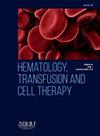Sickle cell disease and increased adverse maternal and perinatal outcomes in different genotypes
IF 1.8
Q3 HEMATOLOGY
引用次数: 0
Abstract
Background
Sickle cell disease (SCD) comprises a heterogeneous group of inherited hemolytic disorders that increases the risk of maternal and perinatal complications due to chronic systemic inflammatory response, endothelial damage and vaso-occlusion. The contribution of genotypes to the severity of outcomes during pregnancy is not completely established.
Methods
A retrospective study of medical charts was performed to compare maternal and perinatal outcomes in Hb SS, Hb SC disease and sickle-beta thalassemia (Hb Sβ) pregnancies followed at a high-risk antenatal care unit over a 6-year period. A descriptive analysis of morphological findings was performed of the placenta when pathology reports were available.
Results
Sixty-two SCD pregnant women [25 Hb SS (40 %), 29 Hb SC (47 %) and 8 Hb Sβ (13 %)] were included. Overall, SCD was associated with maternal complications (77 %), preterm birth (30 %), cesarean section (80 %) and a need of blood transfusion. In general there were no statistically significant differences between genotypes. The only significant difference was the hemoglobin level at first antenatal care visit which was lower for the homozygous genotype (7.7 g/dL) compared to Hb SC and Hb Sβ (9.7 g/dL and 8.4 g/dL, respectively; p-value = 0.01). Ten of 15 evaluated placentas showed abnormal morphological findings
Conclusion
SCD, regardless of the underlying genotype, is associated with increased adverse maternal and perinatal outcomes and placental abnormalities associated with maternal vascular malperfusion.
镰状细胞病以及不同基因型的孕产妇和围产期不良结局的增加。
背景:镰状细胞病(SCD)是一组遗传性溶血性疾病,由于慢性全身炎症反应、内皮损伤和血管闭塞,增加了孕产妇和围产期并发症的风险。基因型对妊娠期严重后果的影响尚未完全确定:方法:我们对病历进行了回顾性研究,以比较在高风险产前护理单位随访 6 年的 Hb SS、Hb SC 病和镰状β地中海贫血(Hb Sβ)孕妇的孕产妇和围产期结局。在有病理报告的情况下,对胎盘的形态学结果进行了描述性分析:结果:共纳入 62 名 SCD 孕妇[25 名 Hb SS(40%)、29 名 Hb SC(47%)和 8 名 Hb Sβ(13%)]。总体而言,SCD 与产妇并发症(77%)、早产(30%)、剖宫产(80%)和输血需求有关。总体而言,不同基因型之间没有显著的统计学差异。唯一显著的差异是首次产前检查时的血红蛋白水平,与 Hb SC 和 Hb Sβ(分别为 9.7 g/dL 和 8.4 g/dL;p 值 = 0.01)相比,同卵基因型的血红蛋白水平较低(7.7 g/dL)。在 15 个接受评估的胎盘中,有 10 个出现异常形态学结果 结论:无论基础基因型如何,SCD 都与不良的孕产妇和围产期结局增加以及与孕产妇血管灌注不良相关的胎盘异常有关。
本文章由计算机程序翻译,如有差异,请以英文原文为准。
求助全文
约1分钟内获得全文
求助全文
来源期刊

Hematology, Transfusion and Cell Therapy
Multiple-
CiteScore
2.40
自引率
4.80%
发文量
1419
审稿时长
30 weeks
 求助内容:
求助内容: 应助结果提醒方式:
应助结果提醒方式:


